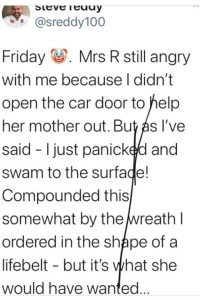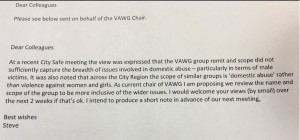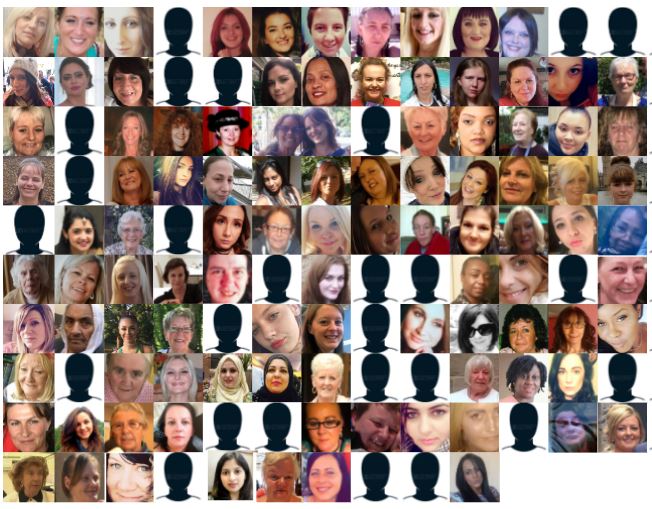No, Angela Crawley, in the UK, it’s not the same and it’s not a greater risk
In the Women and Equalities Select Committee on reform of the Gender Recognition Act on 21 April 2021, Angela Crawley, Scottish National Party MP for Lanark and Hamilton East and the SNP Shadow Attorney General asked
” Would you agree, and I think we can all agree on the prevalence of male violence, and the instance of how often this occurs and often it is a male perpetrator against a female individual, would you agree that individuals who perhaps, perhaps a trans female has transitioned*, they are also at equally and perhaps greater risk of the same violence and the same issues that you’ve expressed around patriarchy. Would it be possible for a women’s refuge to have a policy that is both inclusive provides that safety that provides those single sex spaces built also is able to provide a service that recognises that individuals who are transgender may also be the victims of the very same violence and they might also need protection from those very similar services that we’re discussing.”
(*It’s anyone’s guess who she means here? A trans female who has transitioned surely means female to ‘transman’, but I think she is so determined not to use words referring to maleness for ‘transwomen’ that she means a male who has so-called transitioned to ‘transwoman.’)
Firstly, let’s get this out of the way, you cannot be both single sex and trans inclusive, unless you mean women and ‘transmen’ together or men with ‘transwomen’. If you have transwomen in a women’s refuge it is not single sex. It cannot be.
Angela Crawley seemed to be trying to say that trans people are perhaps more at risk from the same men’s violence as women are. This isn’t true with regards to fatal violence. Men’s fatal violence against males who identify as transgender does not follow the same pattern as men’s fatal violence against women.
As far as I know, nine males who fall under the trans umbrella have been killed in the UK since 2009. I don’t know which of them would have described themselves as cross-dressers, transsexuals, transwomen, trans women, or even say that they are women but using Stonewall’s concept of the trans umbrella, there are nine and I don’t want to open myself to accusations of undercounting. There have been over 1,800 women killed by men in the UK in the same time. These 9 people are
- Andrea Waddel, 29, killed by a punter (sex buyer), Neil McMillan, in Brighton in October 2009
- Destiny Lauren, 29, killed by a punter (sex buyer) Leon Fyle, in London in November 2009
- David/Sonia Burgess, 63, killed by Senthooran (Nina) Kanagasingham, a trans friend/associate (male who identified as trans at the time), in London in October 2010
- Lionel/Suzie Morl, 49, referred to in the press as a transvestite, who was killed by a couple with drug problems and who appear to have been exploiting him: David Hardman, 51, and Tracey Hurrell, 32, in Manchester in July or August 2011. Note the age difference between this couple, which is often (not always) an indicator of an abusive relationship
- Chrissie Azzopardi, 22, who was killed by a neighbour, Romy Maynard, possibly over drug debts, in London in April 2012
- Vanessa Santillan, 33, who was killed by husband Joaquin Hernandez in London in March 2015
- William Lound, 30, a gay man who occasionally wore clothes that have been described as women’s clothes, was killed by Lee Arnold. Arnold killed Lound after the two had had sex, in Salford in August 2016. The murder of William Lound has been described both as a homophobic murder and an anti-trans one
- Naomi Hersi, 36, who was killed by punter (sex buyer) Jesse McDonald after a drugs and sex hook-up in London in March 2018
- Amy Griffiths, 51, was killed by Martin Saberi, in Worcestershire on 11 January 2019. The two have been described as friends.
None of those above were killed in Scotland, where Angela Crawley is an MP. None. Since 2009, at least 129 women have been killed by men in Scotland. 17 women have been killed by men in Scotland since the last known murder of a trans person in the UK. Why can’t you see or why do you turn your back on the violence done to women by men, Angela?
We know from the Femicide Census that 62% of women who were killed by men between 2009 and 2018 were killed by a current or former partner. In the year ending March 2020, the Office for National Statistics says that 46% of adult females and 7% of males were killed in domestic homicides. The ONS also said that 29% of female homicide victims recorded no suspect had been charged for the offence at the time of analysis. This will decrease as investigations proceed and the percentage of cases where a woman’s current or former partner is identified as being responsible for her death is likely to increase. The proportion of males killed by current or former partners is consistent with previous years. 8% of male homicide victims were killed by a partner in the year ending March 2019, 1% in the year ending March 2018 and 3% in the year ending March 2017. Note also that males are much more likely to be killed by a same sex partner, fatal violence is very rare in lesbian relationships.
Given the number of trans people killed in the UK, annual trends in the composition of their relationships with their killer isn’t possible. There have been nine over eleven years and none since Amy Griffiths in 2019. Only one was killed by their partner. Most women’s refuges work exclusively with women who are fleeing partners, ex-partners and in some cases, family members. That doesn’t mean other people don’t need places of safety or support but it does mean that their experiences are different and their needs are too. Women in refuges benefit from being able to place what was done to them in the context of the abuse that other women have been subjected to by men they loved. Sometimes it is through seeing that another woman was not to blame for what was done to her that they are able to begin to stop blaming themselves. Sharing with and listening to other women is a huge part of healing and moving on. Women don’t enter refuges for fun. For most there is no other choice and many are in fear of their life. The number of men who kill or attempt to kill their female partners shows that women’s fears are well grounded. I’ve written in other places about the importance of single-sex spaces for women who have been subjected to men’s violence, for example here, about the necessity of trauma informed services for women being single sex and here, more generally in a speech I delivered in Scottish Parliament in January 2020.
Looking beyond fatal violence and at childhood sexual abuse, prevalence is not equal or greater for males who identify as transgender than it is for females. We know that both girls and boys can be subjected to child sexual abuse and that grooming of younger gay males by older men is an established form of abuse normalised by some men. Prevalence studies for England and Wales suggests that approximately 15% of girls/young women and 5% boys/young men are subjected to some form of sexual abuse before they are 16 years old and that the majority of perpetrators – prevalence studies always indicate over 90% – are male.[1] For women and girls, single sex space to address what has been done to them is vital. For males, who are far more likely to have been abused by someone of the same sex, the preferred or most beneficial sex of their therapist, counsellor, support worker or fellow therapeutic group members can be less clear. Sometimes but not always depending on the sex of their abuser, they may or may not have a preference for or therapeutic issues with the sex of who supports them.[2] The needs of these men should be addressed but this necessary provision should not affect the needs of the majority of female victim-survivors and provision of single sex services to meet their needs; neither should the support and therapeutic needs of males survivors of childhood sexual violence and abuse who come to identify as transgender.
It should not be seen as, and it is not, an indication of disrespect to Andrea Waddel, Destiny Lauren, Sonia Burgess, Suzie Morl, Chrissie Azzopardi, Vanessa Santilan, William Lound, Naomi Hersi and Amy Griffiths to say that with regards to intimate partner homicide, the pattern of their relationships with the person who killed them is far closer to that of male-on-male fatal violence than that of men’s lethal violence against women. Of course what was done to them is abhorrent. But, the evidence suggests that the same services as those under short supply for women would not have saved the lives of most of these trans people.
By identifying the context of the sex industry, which inherently abusive; or substance use, I am not excusing what was done to these people any more than I would consider involvement in prostitution or drug use as an excuse for killing women, or any more than I would hold any woman responsible for abuse perpetrated against her. Prostitution turns people into products and abusive, predatory men who fully recognise the power imbalance in the transaction, into consumers. Prostitution puts people, mainly women, in situations where they are easy prey to murderous men. It is the twisted logic of sex trade advocates that creates a space for victim blaming and denies that prostitution is abuse.
Where fatal violence is concerned, the evidence is that the violence perpetrated against trans people, is not the same violence as that which is perpetrated against women. It’s not the same, it might be proportionate, there aren’t reliable statistics on the number of trans identifying people in the UK so we can’t calculate. Of course not all violence and abuse is fatal, but we can still learn a lot about violence from that which is. It is possible that rates of fatal violence against trans people by men are higher than those of males against women if we take population sizes into account, but this would make that violence more in line with men’s violence against other men, after all men kill more men every year than they kill women. This does not justify removing the single sex exemptions permissible under the Equality Act in the provision of services for women who have been subjected to men’s violence and more than any other form of men’s violence against other men.
Like most people, I do not want to see trans people suffering violence, harassment and discrimination. Universal human rights are an important principle. If we want to stop violence, including fatal violence against trans people, we would be better placed addressing the drivers of violence and abuse of people who do not conform to the gender stereotypes associated with their sex. As a feminist, I would say that we would be better placed dismantling sex-role or gendered stereotypes. Being abused and/or killed as or because you are a gender non-conforming man is not the same as being abused and/or killed as or because you are a women. We help no one if we don’t acknowledge who is doing what to whom and why, or by falsely claiming that that violence against trans people is the same as men’s violence against women.


 This is Karen Cleary-Brown. She was 44 years old and had lived in Islington, N, London for 20 years. She had been missing in Jamaica since 25 November. She was found dead on 3rd December. A man who was working on her property has been charged with her murder.
This is Karen Cleary-Brown. She was 44 years old and had lived in Islington, N, London for 20 years. She had been missing in Jamaica since 25 November. She was found dead on 3rd December. A man who was working on her property has been charged with her murder. This is Barbara Findley. She was 58 and from Kennington, S. London but had lived in Jamaica for the last 5 years. She was reported missing on 29 November. She was found dead on 5 December.
This is Barbara Findley. She was 58 and from Kennington, S. London but had lived in Jamaica for the last 5 years. She was reported missing on 29 November. She was found dead on 5 December.
